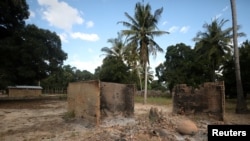A video that appears to show Mozambican security forces torturing and possibly killing militants is prompting calls for investigations, as well as denials from government officials.
Amnesty International obtained five videos and three photos it says were taken in the restive Cabo Delgado region. The images have been analyzed by the group’s Crisis Evidence Lab, which believes they are authentic and were taken in the first six months of 2020.
Brian Castner, Amnesty International's senior crisis adviser for arms and military operations, told VOA that one video shows soldiers cheering while bound detainees are kicked and beaten with rifle butts.
“In one case, one of the soldiers cuts the ear off one of the detainees, presents it to him while people cheer,” Castner said. “In another case, they threaten to light the body on fire or light the person on fire here while they're still alive.”
On Thursday, Omar Saranga, the spokesperson for Mozambique’s defense ministry, said that the images should be viewed with skepticism. The military attire in these videos and images “should not be taken for certain and are [not] accurate,” he told reporters, speaking in Portuguese at a press conference in Maputo.
The assailants appear to be from the Mozambique Armed Defense Forces (FADM) and the Mozambique Rapid Intervention Unit (UIR), based on their uniforms, Amnesty said.
Saranga said that extremist groups and insurgents seek to discredit security forces by wearing their attire.
“One of the tactics used by terrorists in their macabre incursions against the population is to pretend to be elements of the defense and security forces in an attempt to confuse or mislead national and international public opinion,” he said.
The rights group's researchers didn't take “the nature of the reductionist propaganda” into account, Saranga said, adding that the aim of the terrorist groups is “to denigrate the image of the defense and security forces.”
Outside investigation
Despite the government's stance, Amnesty believes it is essential for an impartial body to conduct a thorough investigation.
“The next step is that the government does need to do a real investigation and not a whitewash investigation, an immediate denial, not calling it ‘fake news’ or whatever else. They need to do a real investigation,” Castner said. “And that doesn't mean the police and the army investigating themselves, but an outside office and outside investigative arm of the government.”
The motive for the attacks appears to be retaliation, Castner added. In one of the videos, a soldier appears to refer to his deployment to the region, saying, “I’m here because of you.”
“They're not asking any questions,” Castner said. “This is not an interrogation. It definitely seems to be punishment in at least one of the videos.”
The region in northern Mozambique is home to some of the largest liquid natural gas extraction projects on the continent. It has also become extremely violent in recent years, with 1,854 deaths from organized violent attacks since 2017, according to the Armed Conflict Location & Event Data Project.
One of the most prominent insurgent groups is al-Shabab and has links to the Islamic State group, though it is made up of mostly local youth. It has orchestrated attacks on Mozambican forces as well as foreign mercenaries.
In March, the armed group launched a series of attacks and took over a major town in the region, Mocimboa da Praia, in addition to other nearby towns. In April and May, government forces launched an offensive and retook these towns. Amnesty believes the torture seen in the videos took place during this time.
David Matsinhe, a human rights researcher with Amnesty International Southern Africa, said that while much attention and focus of news coverage has been about understanding the links between insurgents and foreign extremist groups, they are actually local people with local grievances. After gold, rubies, graphite and natural gas were discovered in the region, locals lost access to key resources.
“The tipping point appears to have been the expropriation of the land on which people have depended for centuries to provide for food, water, sanitation, all those basic necessities,” Matsinhe said.
Increased susceptibility
This loss of land made young people more susceptible to radicalization, Matsinhe said.
“It was easier for a radical preacher who may have come in to convince the young people, because 80% of radicalization had been accomplished by the material conditions, through the relationships between the community and the government,” Matsinhe said.
The Mozambican government has called for a stronger response to the issue of militants and instability in the region. During a meeting between southern African leaders in May, Filipe Nyusi, Mozambique's president, said forming a unified force to tackle the issue of extremism in the region was the best way forward.
But Matsinhe said that without addressing internal abuses from security forces and without holding attackers to account, it will be difficult for the government to win back the support of locals.
“The way the country is continuing, it's not sustainable,” he said. “We do not want to see Mozambique in ashes because of violence and violations of human rights.”
VOA Portuguese service’s Ramos Miguel contributed to this report from Maputo and Amancio Vilanculos contributed from Washington.
